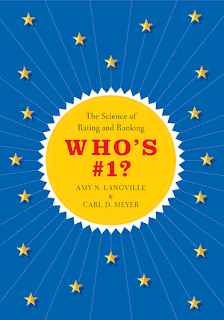 They are the authors of Google's PageRank and Beyond: The Science of Search Engine Rankings.
They are the authors of Google's PageRank and Beyond: The Science of Search Engine Rankings.They applied the “Page 99 Test” to their new book, Who's #1?: The Science of Rating and Ranking, and reported the following:
Who's #1? contains methods, algorithms, applications, and measures for sorting any group of items from most to least important. The items being ranked can range from products to political candidates to sports teams. Example in the book describe how large companies such as Netflix use these methods to rate movies or Google to rank webpages or Facebook to rank people.Learn more about Who's #1?: The Science of Rating and Ranking at the Princeton University Press website.
With respect to the Ford Madox Ford test, p. 99 of Who's #1? concerns one particular method for ranking items. This page is representative of the book in its structure as the page contains a few matrices and a small illustrative 5-team example. In fact, this example is referred to as the running example because each chapter uses this same data to demonstrate its methods. Being technical in nature, p. 99 is hard to understand in isolation. For example, p. 99 introduces a diagram that appears on p. 100, which is representative of the book's emphasis on figures. Because "a picture is worth a thousand words," the 247-page Who's #1? contains 64 figures and 54 tables aimed to easily convey the underlying structure of the mathematical terms.
There are a few additional features meant to aid and entice the reader. For example, sprinkled throughout each chapter are boxes that highlight and summarize main ideas or present a ranking method as a simple step-by-step recipe. In addition, the technical material of each chapter is broken by a few asides, which describe an interesting application, historical story, or current event associated with the chapter's ranking method.
In summary, it is hard to get a sense of these features of the book and its coherence solely from p. 99. Thus, for technical or scientific books, we propose modifying the p. 99 test a bit. How about, instead, a Chapter 9 test? A quick skim through a full chapter in a scientific book such as Who's #1? gives a more complete picture of the structure and presentation of the material. (By the way, Chapter 9 of Who's #1? is about point spreads and gambling. So perhaps the information you gain from the entire book will enable you to beat the spread for next year's big game.)
We hope you enjoy our book and we look forward to your feedback. If you do well, don't forget to send us a postcard from Vegas.
--Marshal Zeringue



